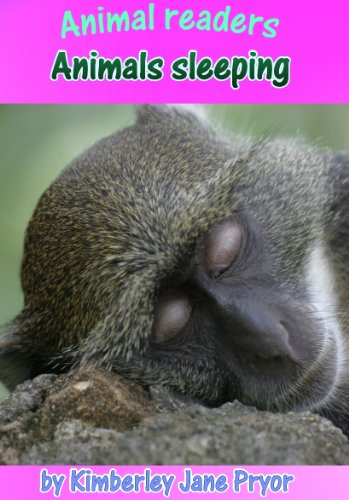-
Ways Animals Sleep
Jane R. McCauley
Hardcover (National Geographic Society 1983, Jan. 1, 1983)HARDCOVER
-
Ways animals sleep
Jane R McCauley
Paperback (National Geographic Society, Jan. 1, 1983)Describes the different methods of sleep of a variety of mammals, fish, insects, and birds. Includes such details as postures of sleep, location, duration, and special adaptation to habitat.
-
How Animals Sleep
Sylvaine Peyrols
Spiral-bound (Moonlight Publishing, Dec. 1, 2015)A unique look at the many varying ways, times, and places that different animals sleepMammals, insects, fish, and reptiles all get tired like us and need to sleep. This book illustrates vividly how and where they sleep in many different ways and at different times. Fish, snakes, and insects sleep with their eyes open. Birds sleep perched in trees without falling off. Bats sleep upside down for 20 hours a day. Sleeping whales and dolphins keep a part of their brains awake at all times so that they can go to the surface when they need air. Horses, elephants, zebras, and giraffes sleep standing up and for less than 4 hours a day. K
K
-
Animals Asleep
Sneed B. Collard III, Anik McGrory
Hardcover (HMH Books for Young Readers, March 23, 2004)The average human sleeps a total of twenty-four years over a lifetime. That’s a lot of naps! Yet people aren’t the only ones who enjoy a good rest; if you look around, you’ll find that all animals have a biological need for sleep. But some animals snooze in ways that we would find startling—if not absolutely impossible. A sooty tern, an island bird, takes a nap in midair as it slowly flaps its wings. A fruit bat gets forty winks while hanging upside down from a tree branch. A bottlenose dolphin can put half of its brain to sleep while it continues to swim. What other remarkable methods of sleep exist? LB
LB
-
Ways animals sleep
Jane R McCauley
Unknown Binding (National Braille Press, Jan. 1, 1988)None
-
Sleepy Animals
Suzy Davies, Laurie Shanholtzer
Paperback (Independently published, May 15, 2019)Sleepy Animals is a book for children, filled with lovable baby animals they’ll want to love and cuddle. Words and pictures take them into imaginative dream-like places. Ideal to read at bedtime, this book, illustrated with enchanting pastel pictures, will relax and soothe your child encouraging a restful night’s sleep.
-
Sleepy animals
Kimberley Jane Pryor
language (Kimberley Jane Pryor, June 4, 2012)In this simple ebook, babies and toddlers will be able to look at 12 very sleepy animals.Each page has a photograph of one sleepy animal. The name of the sleepy animal is underneath the photograph.The sleepy animals featured are: bear, camel, dog, duck, hippopotamus, koala, lion, monkey, orangutan, polar bear, porcupine and tapir.Sleepy animals is Book 8 in the First animals series. The First animals series is ideal for babies to 3 year olds who are just discovering the wonderful animals that share our world.
-
Animals sleeping
Kimberley Jane Pryor
language (Kimberley Jane Pryor, June 24, 2012)In this cute bedtime book, beginning readers will enjoy learning about the ways different animals sleep.Animals sleeping has colourful photographs and simple text to help build reader confidence.The animals featured are: lioness, wolf, cat, otter, dog, prairie dog, meerkat, monkey, sheep, cow, pig, kangaroo, fox, chimpanzee, owl, koala, hippopotamus, swan, seal, turtle, rhinoceros, polar bear, bear and tiger.Animals sleeping is Book 8 in the Animal readers series. The Animal readers series is ideal for 2 to 7 year olds who are curious about animals and want to learn more about them.
-
Where Do Animals Sleep?
Pam Holden
Paperback (Flying Start Books, Jan. 21, 2014)Animals need a place to sleep at night where they will have shelter from the weather and from their enemies. A fish cant sleep in a tree! A sheep doesnt sleep in a basket! Do you know where bats go to sleep at night? C
C
-
Animals Asleep
Sneed B. Collard III, Anik Scannell McGrory
Hardcover (Houghton Mifflin Books for Children, March 23, 2004)The average human sleeps a total of twenty-four years over a lifetime. That’s a lot of naps! Yet people aren’t the only ones who enjoy a good rest; if you look around, you’ll find that all animals have a biological need for sleep. But some animals snooze in ways that we would find startlingif not absolutely impossible. A sooty tern, an island bird, takes a nap in midair as it slowly flaps its wings. A fruit bat gets forty winks while hanging upside down from a tree branch. A bottlenose dolphin can put half of its brain to sleep while it continues to swim. What other remarkable methods of sleep exist? L
L
-
Animals Sleeping
Wendy Perkins
Library Binding (Capstone Press, Jan. 1, 2004)Perkins, Wendy L
L
-
How Animals Sleep
Emily C. Dawson
Paperback (Riverstream Pub, )None N
N